2022 Volvo XC40 Pilot Assist
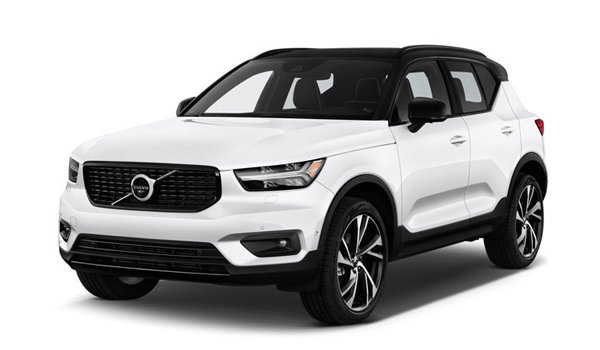
Automatic braking with cruise control functions
Brake function in slow queues and while stationary
For shorter stops in connection with creep mode in slow traffic or at traffic lights, driving is automatically resumed if the stops do not exceed approx. 3 seconds – if it takes longer before the vehicle in front starts moving again then the driver support function is set in standby mode with automatic braking.
The function is reactivated in one of the following ways:
- Press the steering wheel button.
- Depress the accelerator pedal.
The function resumes following the vehicle ahead if it starts moving forward within approx. 6 seconds.
Warning
A significant increase in speed may follow when the speed is resumed with the steering wheel button.
Warning
The driver supports only warn of obstacles which their radar unit has detected – hence a warning may not be given, or it may be given with a certain delay.
- Never wait for a warning or intervention. Apply the brakes when the situation requires.
Note
The driver supports can hold the car stationary for a maximum of 10 minutes – then the parking brake is applied and the function is disengaged.
Before the driver support can be reactivated, the parking brake must be released.
Cessation of automatic braking
In some situations, automatic braking ceases on coming to a standstill and the function is set in standby mode. This means that the brakes are released and the car may start to roll – the driver must therefore intervene and brake the car himself/herself to keep it stationary.
This may take place in any of the following situations:
- The driver puts his/her foot on the brake pedal.
- The parking brake is applied.
- The gear selector is moved to the P, N, or R position.
- The driver sets the adaptive cruise control or Pilot Assist to standby mode.
Automatic activation of the parking brake
The Parking brake is applied if the function is holding the car stationary with the foot brake and:
- The driver opens the door or takes off his/her seatbelt.
- The function has kept the car stationary for more than approx. 10 minutes.
- The brakes have overheated.
- The driver switches the engine off.
Setting the stored speed for cruise control functions
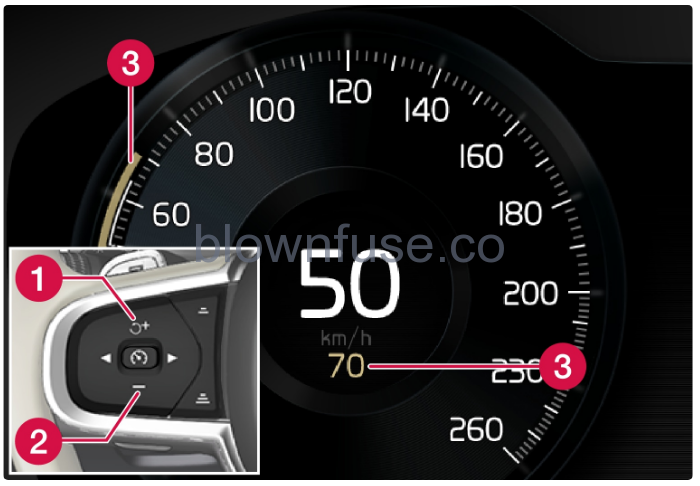
 |
|
 |
|
 |
Stored speed |
Change a set speed with short presses on the steering wheel buttons ![]() (1) or
(1) or ![]() (2) or by pressing and holding them.
(2) or by pressing and holding them.
- Short presses: Each press changes the speed in increments of +/- 5 km/h (+/- 5 mph).
- Press and hold: Release the button when the speed indicator (3) has moved to the desired speed.
The speed setting after the last button press is stored in the memory.
Effect of the accelerator pedal
If the driver increases the car’s speed using the accelerator pedal before pressing the steering wheel button ![]() (1), the speed stored will be the car’s speed when the button is depressed, provided the driver’s foot is on the accelerator pedal at the moment when the button is depressed.
(1), the speed stored will be the car’s speed when the button is depressed, provided the driver’s foot is on the accelerator pedal at the moment when the button is depressed.
A temporary increase in speed with the accelerator pedal, e.g. during overtaking, does not affect the setting – the car returns to the last stored speed when the accelerator pedal is released.
Possible speed
Automatic gearbox
- The driver support functions can follow another vehicle at speeds from 0 km/h up to 180 km/h (112 mph).
- Pilot Assist can give steering assistance from almost stationary up to 140 km/h (87 mph).
- Note that the lowest programmable speed is 30 km/h (20 mph) – even though it is capable of following another vehicle down to 0 km/h, a speed lower than 30 km/h (20 mph) cannot be selected/stored.
Manual gearbox
- The driver support functions can follow another vehicle at speeds from 30 km/h (20 mph) up to 180 km/h (112 mph).
- Pilot Assist can give steering assistance from 30 km/h (20 mph) up to 140 km/h (87 mph).
- The lowest programmable speed is 30 km/h (20 mph) – the maximum speed is 200 km/h (125 mph).
Change of target with cruise control functions
Change of target
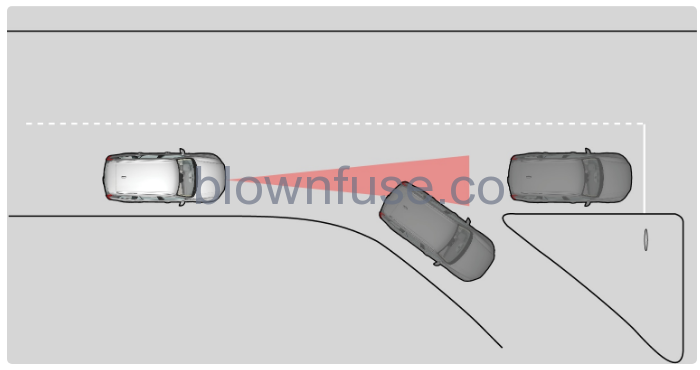 If the target vehicle in front suddenly turns then there may be stationary traffic in front.
If the target vehicle in front suddenly turns then there may be stationary traffic in front.When the driver supports are following another vehicle at speeds below 30 km/h (20 mph) and changes the target vehicle – from a moving vehicle to a stationary vehicle – the driver supports will slow down for the stationary vehicle.
Warning
When the driver supports are following another vehicle at speeds in excess of approx. 30 km/h (20 mph) and the target is changed from a moving vehicle to a stationary vehicle, the driver support will ignore the stationary vehicle and instead accelerate to the stored speed.
- The driver must then intervene him/herself and brake.
Automatic standby mode with the change of target
The driver supports are disengaged and set in standby mode:
- when the speed is below 5 km/h (3 mph) and the driver supports are uncertain whether the target object is a stationary vehicle or another object, such as a speed bump.
- when the speed is below 5 km/h (3 mph) and the vehicle ahead turns off so that the driver supports no longer has a vehicle to follow.
Pilot Assist
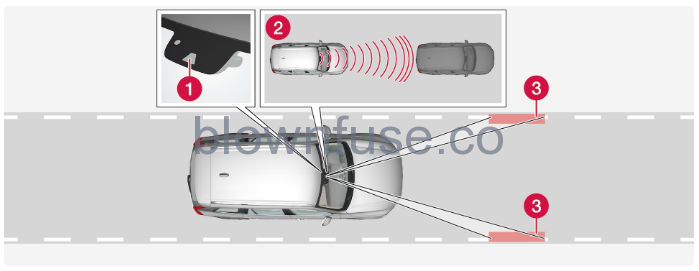 The camera and radar unit measure the distance to the vehicle ahead and detect side markings.
The camera and radar unit measure the distance to the vehicle ahead and detect side markings.- Camera and radar unit
- Distance readers
- Readers, side markings
Get to know Pilot Assist
Pilot Assist helps to control your car and you may need to drive a few kilometres with Pilot Assist before you feel completely at home with the function. It is important to know about all of the function’s applications and limitations in order to safely use all of the advantages.
The Pilot Assist function is primarily intended for use on motorways and similar major roads where it can contribute to more comfortable driving and a more relaxed driving experience.
The driver selects the desired speed and a time interval for the vehicle ahead. Pilot Assist scans the distance to the vehicle ahead and the lane’s side markings on the road surface using the camera unit. The preset time interval is maintained with automatic speed adjustment whilst the steering assistance helps to position the car in the lane.
Pilot Assist regulates the speed with acceleration and braking. It is normal for the brakes to emit a low sound when they are being used to adjust the speed.
Pilot Assist strives to:
- regulate the speed smoothly. In situations that demand sudden braking, the driver must brake himself/herself. This applies in cases of large speed differences or if the car in front brakes suddenly. Due to the limitations of the camera and radar unit, braking may come unexpectedly or not at all.
- follow the vehicle ahead in the same lane at a time interval set by the driver. If the radar unit cannot see any vehicle in front then the car will instead maintain the speed set and stored by the driver. This also takes place if the speed of the vehicle ahead increases and exceeds the stored speed.
Position of the car in the lane
When Pilot Assist helps to steer, it attempts to place the car halfway between the visible lane markings. For a smoother drive, it is a good idea to allow the car to find a good position. The driver can always adjust the position him/herself by increasing the steering input. It is important that the driver checks to make sure the car is positioned safely in the lane. If Pilot Assist does not position the car in an appropriate way in the lane, it is recommended to turn Pilot Assist off or switch to adaptive cruise control.
Steering assistance

The current status of steering assistance is indicated by the colour of the steering wheel’s symbol:
• Steering wheel lit up indicates active steering assistance
• Steering wheel extinguished (as in the illustration) indicates deactivated steering assistance.
Pilot Assist steering assistance takes into account the speed of the preceding car and the lane markings. The driver can at any time adjust steering interventions from Pilot Assist and steer in another direction, e.g. to change lanes or avoid an obstruction on the road. Resistance is then felt in the steering wheel as long as the steering assistance is active.
Temporary disabling of steering assistance
Pilot Assist steering assistance is automatically deactivated and is resumed without prior warning.
When the direction indicators are used, Pilot Assist steering assistance is temporarily disengaged. When the direction indicator is switched off, steering assistance is reactivated automatically if the lane’s edge markings can still be detected.
If Pilot Assist is unable to interpret the lane clearly, e.g. if the camera unit does not see the lane’s edge markings, Pilot Assist shuts off steering assistance temporarily. Speed and distance regulating functions remain active. Steering assistance is resumed when the lane can be interpreted again. In these situations, slight vibration in the steering wheel may alert the driver to the fact that steering assistance has been deactivated temporarily.
Round bends and when the road splits
Pilot Assist interacts with the driver, who should therefore not wait for the steering assistance from Pilot Assist but should always be prepared to increase his/her own steering input, especially in bends. When the car approaches an exit or if the lane splits, the driver should steer towards the desired lane so that Pilot Assist can detect the desired direction.
Hands-on the steering wheel

In order for Pilot Assist to function, the driver’s hands must be on the steering wheel. It is also important for the driver always to carry on being active and alert when driving as Pilot Assist is unable to read all situations and the function may toggle between off and on without prior warning.
Warning
Do not wait for all levels of warning and assistance from the systems, but act immediately if any warning signal is triggered.
- If Pilot Assist detects that the driver does not keep his/her hands on the steering wheel, the system gives a warning with a symbol and text message in the driver’s display in order to prompt the driver to actively steer the car.
- If the driver’s hands still cannot be detected on the steering wheel after a few seconds the prompt to actively steer the car is repeated supplemented by an acoustic signal.
- If Pilot Assist does not detect the driver’s hands on the steering wheel after a further few seconds then the function is switched off. Following this, Pilot Assist must be restarted using the steering wheel button. After being switched off, the function continues to use acoustic and visual warning signals for up to 5 seconds.
Steep roads and/or heavy load
Bear in mind that Pilot Assist is primarily intended for use when driving on level road surfaces. The function may have difficulty in keeping the correct distance from the vehicle ahead when driving on steep downhill slopes – in which case, be extra attentive and ready to brake. Do not use Pilot Assist if the car has a heavy load or a trailer is connected to the car.
Pilot Assist will not provide steering assistance if something is connected to the towbar connector, like a trailer or a bicycle rack.
Read all warnings before use
- The function is supplementary driver support intended to facilitate driving and make it safer – it cannot handle all situations in all traffic, weather and road conditions.
- The driver is advised to read all sections in the Owner’s Manual that relate to this function to learn about factors such as its limitations and what the driver should be aware of before using the system.
- Driver support functions are not a substitute for the driver’s attention and judgement. The driver is always responsible for ensuring the car is driven in a safe manner, at the appropriate speed, with an appropriate distance from other vehicles, and in accordance with current traffic rules and regulations.
This function uses the car’s camera and radar units, which have certain general limitations.
Maintenance of driver support components must only be performed at a workshop – an authorised Volvo workshop is recommended.
In certain situations, Pilot Assist steering assistance may have difficulty helping the driver in the right way or it may be automatically deactivated – in which case, the use of Pilot Assist is not recommended. Examples of such situations may be:
- the lane markings are unclear, worn, missing, or they cross each other, or if there are several sets of lane markings.
- the lane division is changed, e.g. when the lanes split or merge, as well as on slip roads.
- at roadworks and sudden changes in the roadway, e.g. when the lines may stop marking the correct route.
- edges or other lines than lane markings are present on or near the road, e.g. kerbs, joints or repairs to the road surface, edges of barriers, roadside edges or strong shadows.
- the lane is narrow or winding.
- the lane contains ridges or holes.
- weather conditions are poor, e.g. rain, snow or fog or slush or impaired view with poor light conditions, back-lighting, wet road surface etc.
The driver should also note that Pilot Assist has the following limitations:
- High kerbs, roadside barriers, and temporary obstacles (traffic cones, safety barriers, etc.) are not detected. Alternatively, they may be detected incorrectly as lane markings, with a subsequent risk of contact between the car and such obstacles. The driver must ensure him/herself that the car is at a suitable distance from such obstacles.
- The camera and radar sensor do not have the capacity to detect all oncoming objects and obstacles in traffic environments, e.g. potholes, stationary obstacles or objects which completely or partially block the route.
- Pilot Assist does not “see” pedestrians, animals, etc.
- The functions of steering assist are force limited, which means that Pilot Assist cannot always help the driver steer and keep the car within the lane.
- In cars equipped with Sensus Navigation, the function has the option of using information from map data, which may result in varied performance.
- Pilot Assist is switched off if the power steering for speed-related steering force is working with reduced power – e.g. during cooling due to overheating.
Pilot Assist must only be used if there are clear lane lines painted on each side of the lane. All other use involves an increased risk of contact with surrounding obstacles that cannot be detected by the function.
- This is not a collision avoidance system. The driver is always responsible and must intervene if the system does not detect a vehicle ahead.
- The function does not brake consistently for humans or animals, and neither for small vehicles such as bicycles and motorcycles. Nor for low trailers, oncoming, slow or stationary vehicles and objects.
- Do not use the function in demanding situations, such as in city traffic, at junctions, on slippery surfaces, with a lot of water or slush on the road, in heavy rain/snow, in poor visibility, on winding roads or on slip roads.
Display for adaptive cruise control and Pilot Assist
Graphic
 |
Adaptive cruise control is selected and active. |
 |
Pilot Assist is selected and active. Pilot Assist steering assistance is only active when the steering wheel symbol has switched from extinguished to lit up. |
 |
There is a target vehicle ahead to follow. The time interval to the vehicle ahead is only regulated when the graphic shows a vehicle above. |
Speed
 Indication of speeds.
Indication of speeds.- Stored speed
- Speed of vehicle ahead
- Current speed of your car
Symbols and messages for Pilot Assist
| Symbol | Message | Specification |
|---|---|---|
 |
The steering wheel symbol extinguished | Indicates deactivated steering assistance. When Pilot Assist provides steering assistance, the steering wheel is lit up. |
 |
The symbol for hands on the steering wheel | The system cannot detect whether the driver has his/her hands on the steering wheel. Place your hands on the steering wheel and actively steer the car. |
 |
Windscreen sensor
Sensor blocked, see Owner’s manual |
Clean the windscreen in front of the camera and radar unit’s detectors. |
A text message can be cleared by briefly pressing the ![]() button, located in the centre of the steering wheel’s right-hand keypad.
button, located in the centre of the steering wheel’s right-hand keypad.
If a message remains, contact a workshop – an authorised Volvo workshop is recommended.
Standby mode for Pilot Assist
Standby mode means that the function is selected in the driver display but not activated. In this case, Pilot Assist does not regulate the speed or distance to the vehicle in front or provide steering assistance.
Standby mode on driver intervention
Pilot Assist is deactivated and set in standby mode if any of the following occurs:
- The foot brake is used.
- The gear selector is moved to the N position.
- The direction indicators are used for longer than 1 minute.
- The driver maintains a speed higher than the stored speed for longer than 1 minute.
- The clutch pedal is held depressed for longer than 1 minute – applies to cars with a manual gearbox.
Automatic standby mode
With automatic standby mode, the driver is warned via an acoustic signal and a message on the driver’s display.
- The driver must then regulate the car’s speed, apply the brakes as needed and maintain a safe distance from other vehicles.
Automatic standby mode may be engaged in the event of one of the following.
- One of the systems that Pilot Assist is dependent on stops working, e.g. stability control / anti-skid.
- Hands not holding the steering wheel.
- The driver opens the door.
- The driver takes off the seatbelt.
- The engine speed is too low/high.
- One or more wheels lose traction.
- The brake temperature is high.
- The parking brake is applied.
- The camera and radar unit are covered by e.g. snow or heavy rainfall (camera lens/radio waves are blocked).
- The speed is below 5 km/h (3 mph) and Pilot Assist is uncertain whether the vehicle ahead is a stationary vehicle or an object, such as a speed bump.
- The speed is below 5 km/h (3 mph) and the vehicle ahead turns off so that Pilot Assist no longer has a vehicle to follow.
- The speed is reduced to below 30 km/h (20 mph) – only applies to cars with manual gearboxes.
Setting time interval to vehicle ahead
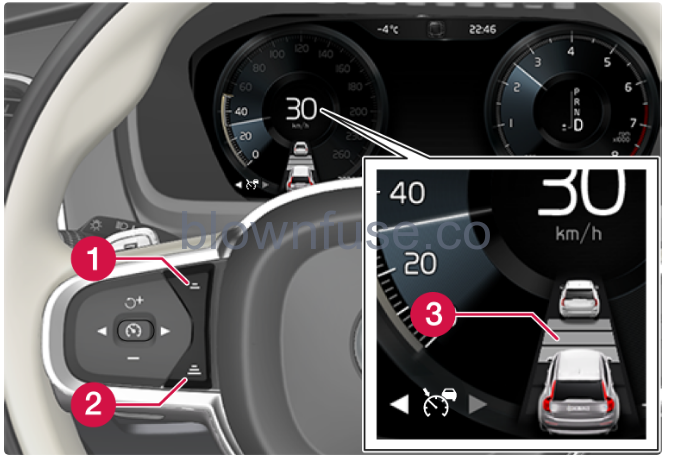 Control for a time interval.
Control for a time interval.- Decrease time interval
-
Increase time interval
-
Distance indicator
-
Press the steering wheel button (1) or (2) to increase or decrease the time interval.
-
The distance indicator (3) shows the current time interval.
-
Different time intervals to the vehicle in front can be selected and shown in the driver display as 1-5 horizontal lines – the more lines the longer the time interval. One line represents about 1 second to the vehicle in front, and 5 lines represent about 3 seconds.
-
The adaptive cruise control allows the time interval to vary significantly in certain situations in order to allow the car to follow the vehicle in front smoothly and comfortably. At low speed, when the distances are short, the adaptive cruise control increases the time interval slightly.
When the symbol in the driver display shows a car and a steering wheel, Pilot Assist follows a vehicle in front at a preset time gap.
When only one steering wheel is shown, there is no vehicle within a reasonable distance ahead.
Note
When only one car is shown, there is no vehicle within a reasonable distance ahead.
- The higher the speed the longer the calculated distance in metres for a given time interval.
- Only use the time intervals permitted by local traffic regulations.
- If the driver supports do not seem to respond with a speed increase when activated, it may be because the time window to the vehicle ahead is shorter than the set time window.
- Only use a time window that suits the current traffic conditions.
- The driver should be aware that short time windows limit the amount of time available to react and take action in an unexpected traffic situation.
Difference between Pilot Assist and lane assistance
Pilot Assist
Pilot Assist can help you to steer your car between the lane’s markings, as well as maintain a preset speed and time interval to the vehicle ahead. The function can also help to maintain an advantageous position in the lane using the lane’s lane lines.
What does Pilot Assist do?
- Can help to keep the car within its lane by assisting with the steering in some cases.
- Can help to maintain a preset speed or the distance to the vehicle ahead by means of acceleration and braking operations.
How do I know when Pilot Assist is operational?
Symbols in the driver’s display in the car indicate when this function is operational.
When the steering wheel in the middle is extinguished, Pilot Assist is running but steering assistance is not active.
When the steering wheel is illuminated, Pilot Assist is running and steering assistance is active.
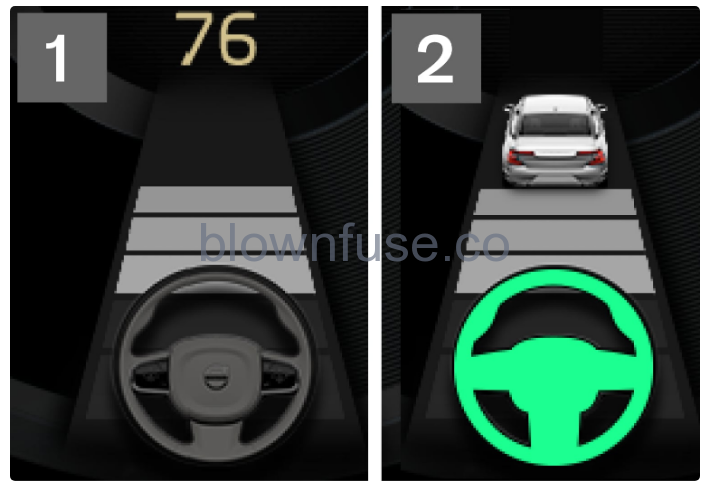 When the steering wheel symbol in the driver display is illuminated, Pilot Assist is helping you to steer.
When the steering wheel symbol in the driver display is illuminated, Pilot Assist is helping you to steer.Lane assistance
Lane assistance can provide steering assistance and/or give you an alert when the vehicle is about to leave its own lane unintentionally. This function is active in the speed range 65-180 km/h (40-112 mph) on roads with clearly visible lane lines.
What does lane assistance do?
- Lane assistance can provide the driver with steering assistance, steering the car back into its lane and/or providing warnings using acoustic signals or steering wheel vibration.
How do I know when lane assistance is operational?
Symbols in the driver’s display in the car show the status of the function.

An extinguished symbol in the driver display means that the function is running but the conditions for LKA have not been met.

A white symbol in the driver’s display means that the conditions for LKA have been met and that the function is available.

An orange symbol in the driver’s display means that LKA is providing steering assistance back into the lane and/or will provide warnings using acoustic signals or steering wheel vibration.
Warning
The driver always bears responsibility for ensuring that the car is driven safely. Before using this function, the driver is recommended to read all sections on the function in the owner’s manual.
Warning
- The function is supplementary driver support intended to facilitate driving and make it safer – it cannot handle all situations in all traffic, weather and road conditions.
- The driver is advised to read all sections in the Owner’s Manual that relate to this function to learn about factors such as its limitations and what the driver should be aware of before using the system.
- Driver support functions are not a substitute for the driver’s attention and judgement. The driver is always responsible for ensuring the car is driven in a safe manner, at the appropriate speed, at an appropriate distance from other vehicles, and in accordance with current traffic rules and regulations.
Warning from cruise control functions in the event of a collision risk
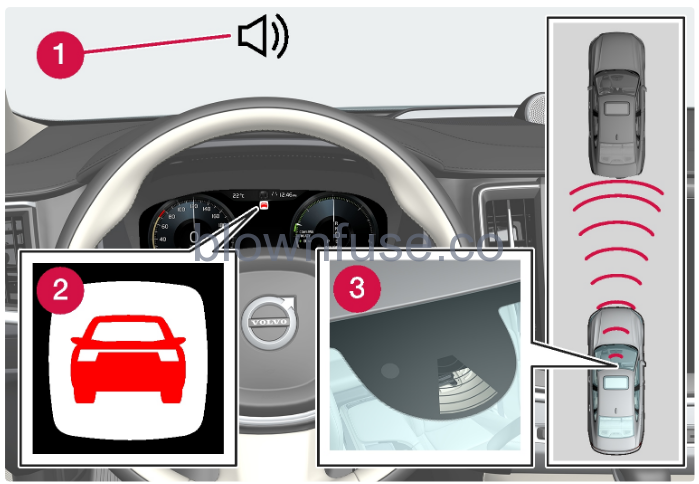 Audio and symbol for collision warning
Audio and symbol for collision warning- Acoustic signal in the event of a risk of collision
- Warning signal in the event of a risk of collision
- Distance measurement with the camera and radar units
- Adaptive cruise control and Pilot Assist use approx. 40% of the capacity of the foot brake.
- If the car needs to be braked more heavily than the driver support is capable of and the driver does not brake, the warning lamp and acoustic warning are activated to alert the driver that immediate intervention is required.
The driver support systems only warn of vehicles that their radar unit has detected – hence a warning may not be given, or it may be given with a certain delay. Never wait for a warning. Apply the brakes when the situation requires.

